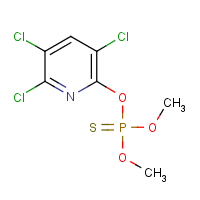Chlorpyrifos-methyl
Agent Name
Chlorpyrifos-methyl
Alternative Name
Chlorpyrifos O,O-dimethyl analog
CAS Number
5598-13-0
Formula
C7-H7-Cl3-N-O3-P-S
Major Category
Pesticides

Synonyms
Chlorpyrifos O,O-dimethyl analog; Chloropyriphos-methyl; Chlorpyrifos methyl; Chlorpyriphos-methyl [ISO-French]; Dowco 214; Dursban methyl; ENT 27520; M 3196; Methyl chlorpyrifos; Methyl chlorpyriphos; Methyl dursban; Methylchlorpyrifos; Noltran; O,O-Dimethyl O-(3,5,6-trichloro-2-pyridinyl) phosphorothioate (8CI)(9CI); O,O-Dimethyl O-(3,5,6-trichloro-2-pyridyl)phosphorothioate; O,O-Dimethyl O-3,5,6-trichloro-2-pyridyl phosphorothioate; OMS-1155; Reldan; Reldan 50 EC; Trichlormethylfos; Tumar; Zertell; [ChemIDplus]
Category
Organophosphate Insecticides
Description
White or amber solid; [HSDB] Colorless solid; [CAMEO]
Sources/Uses
Used as insecticide, acaricide, and veterinary ectoparasiticide; [Merck Index] Used mainly to protect cereals (including storage); [HSDB] Used as insecticide for stored grains, rice, oil crops, and animal feed; [Reference #1]
Comments
A skin irritant; [SAX] May cause skin sensitization; [eChemPortal: ESIS] In a two year feeding study with rats (highest dose level 1 mg/kg/day) no significant adverse gross or histopathological changes were observed as well as no relation to frequency of spontaneous tumors; Effects in a three generation feeding study with rats include inhibition of cholinesterase activity and decreased pup weights in the second and third generation; No significant effects were observed in fertility, gestation, viability, or lactation; No gross or histopathological changes were noted in third generation parental animals; No teratogenic effects observed in a study with rats; [Reference #2] “The average of two baseline respective cholinesterase activity determinations three days apart, with no exposures to enzyme inhibiting pesticides for at least 30 days, is recommended for each worker prior to exposure to cholinesterase inhibitors because of large inter-individual differences in published baseline values. To be established at least once a year. Removal from workplace exposures is recommended until the cholinesterase activity returns to within 20% of baseline.” [TLVs and BEIs] See "Chlorpyrifos."
Reference Link #1
Biomedical References
Exposure Assessment
BEI
Acetylcholinesterase activity in red blood cells = 70% of individual's baseline; Butylcholinesterase activity in serum or plasma = 60% of individual's baseline; Sample at end of shift; [TLVs and BEIs]
Vapor Pressure
4.22E-05 mm Hg
Lethal Concentration
LC50 (rat) > 670 mg/m3/4h
Reference Link #2
Adverse Effects
Other Poison
Organophosphate
Diseases, Processes, and Activities Linked to This Agent
Diseases
Occupational diseases associated with exposure to this agent:
Processes
Industrial Processes with risk of exposure: